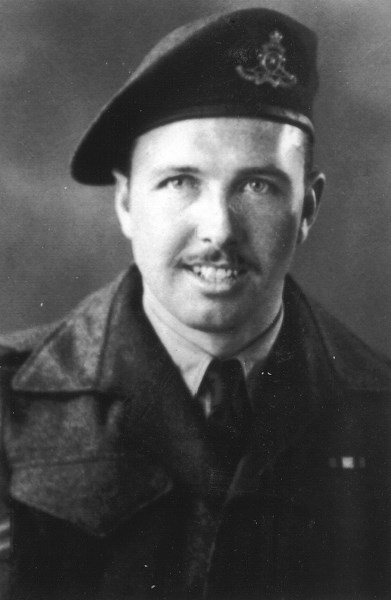Sandy Sommerville experienced more in a few years during the Second World War than many people will experience in a lifetime.
After joining the army in Calgary on Feb. 27, 1941, he did his basic training at Fort William in Ontario before coming to Shilo, Man. for artillery training. On July 3, 1941, he joined the 13th Field Regiment, Royal Canadian Artillery at Debert, N.S.
He shipped out in a convoy consisting of a troopship, two freighters and two destroyers for the voyage to England from Halifax, N.S. on the French liner Pasteur on Nov. 3, 1941.
"We had some very rough weather as we went north towards Iceland," he wrote in a biographical piece detailing his service.
"A lot were sea sick. I felt very sick but never threw up."
The convoy arrived at Gourock, Scotland on Nov. 13, 1941 and he then continued by train to Farmborough, in the south of England, before finally arriving at an old cavalry barracks.
"I spent my first winter in England at Cove, Hants at a signals school," he wrote. "We learned telegraph, radio, flags and lamp using the Morse code. For the next two years, we were on coastal defence, while continuing our training on new equipment and battle plans."
His experience also offered a chance to see "a lot of beautiful old England."
In 1943, as the monumental task of preparing for D-Day was getting underway, he began training on tanks and self-propelled guns.
"I was given a week of driver training on the tanks as it was necessary to have a co-driver in case the driver was unable to do his job. My regular job was signaler, mostly with radio."
Finally, everything was in place and the troops ready for the fateful mission to liberate France and eventually the rest of occupied Europe.
With only a few days to go before the troops were scheduled to embark on their rendezvous with destiny across the English Channel, a lone German plane flew over his staging area and scored a direct hit on one of the self-propelled guns.
"Sometime later, we found out that we had been bombed by the Germans' new secret weapon, a V-1 flying bomb."
Heavily loaded with ammunition, the army's equipment was parked nose to tail on a street in the village of Park Gate near Southampton. He was on guard duty at the time, and the attack destroyed two tanks, four self-propelled guns, one jeep and three motorcycles.
"The fire and explosions were terrible. Thank God there were no lives lost."
Within 24 hours, new equipment was arriving and the troops had to waterproof it all for the landing as well as load the ammunition.
On the afternoon of June 5, 1944, they started out across the channel heading for the coast of France.
"On the way over, we were told where we would be landing and what to expect. Also that 50 per cent casualties would be accepted and that reinforcements were standing by ready to take our place on short notice."
With defences along the entire northern coast of France, the Germans put up a fierce defence "and the battle was hot and heavy."
Enemy aircraft bombarded their position as they worked their way up and off the beach. After 55 days of fighting, they were taken out of the line and their self- propelled guns and tanks were replaced with the 25-pounder field gun. By that point, Sommerville had been promoted to Bombardier, replacing the Troop Signals non-commissioned officer who was wounded in the days following D-Day.
"I had a motorcycle to ride as the job required me to travel between the gun position and the forward observation officer. We were back in battle in less than a week."
It was along the Falaise road that the troops suffered a dose of friendly fire on Aug. 14, 1944 when the Air Force mistakenly bombed their position for more than an hour.
They continued to fight northward along the coast, and took the city of Boulogne before working their way up through Belgium to the Leopold Canal. Despite the odds, the troops cleared the Scheldt and made the port of Antwerp available to the Allies.
The brass decided they had earned a break and were given some time in Ghent, Belgium.
"Our next move was to the Nijmegen area in Holland to relieve a Royal Artillery Regiment and the 101st American Airborne Division."
As the battle pushed the Nazi war machine further back, he was eventually stationed at an observation post in Germany overlooking the Rhine River.
"It was a very good feeling that we had carried the fighting back to Germany, where it all began. We knew we were not done yet as the enemy were now defending their homeland."
His time on the front lines was nearing its end.
On Nov. 12, 1944, he sustained a wound to his leg after repairing a telephone line that had been cut by gunfire.
"We were being shelled and I was hit by a piece of shrapnel in my right thigh."
His comrades applied a field dressing to the wound and he was then taken on a stretcher to a surgical unit several kilometres behind the front line, where the shrapnel was removed.
"The next morning I was taken with a number of other wounded by plane to a hospital at Brussels in Belgium."
By the time he recovered, the war had ended. He remained in Europe for several months after Germany's surrender, and arrived back in Calgary on Oct. 30, 1945, where he was met by Clyde Ruby ó the father of his future wife, Ruth. After spending the night in Calgary, he went to visit his mother's home in Three Hills the next day.



